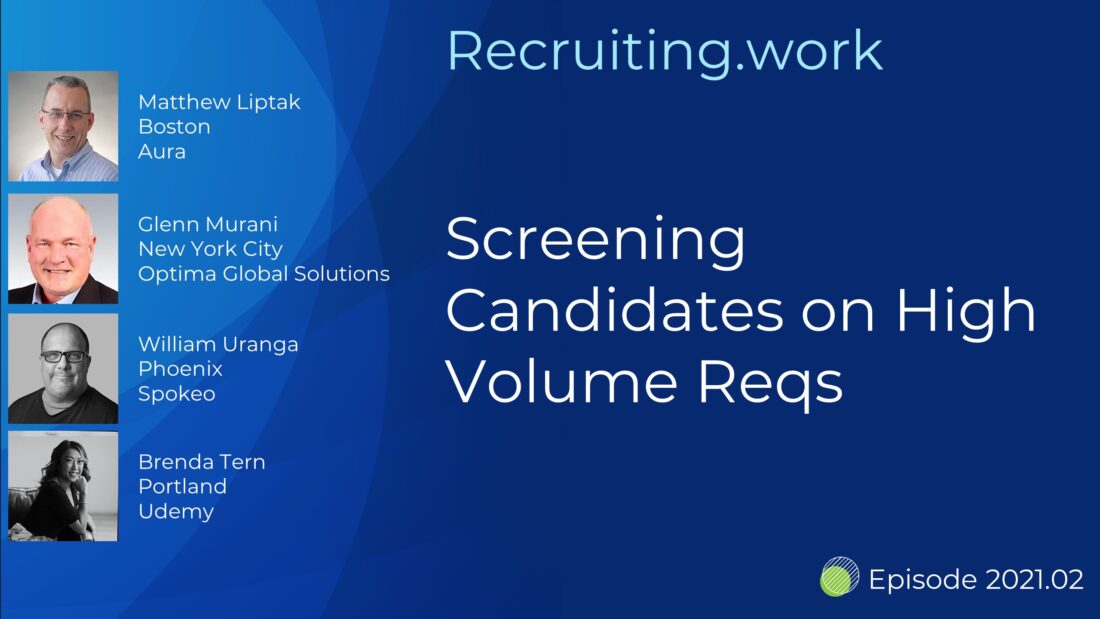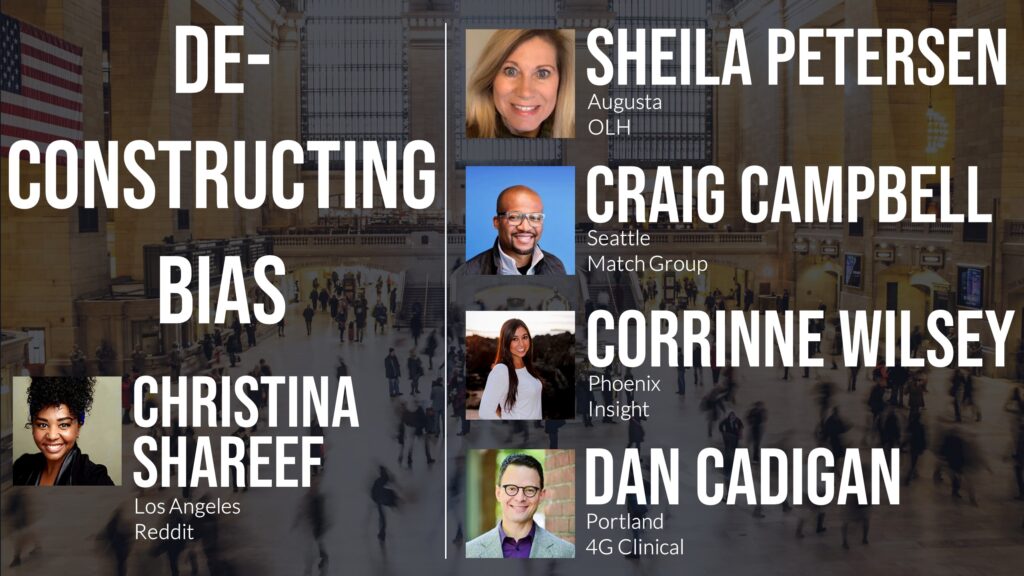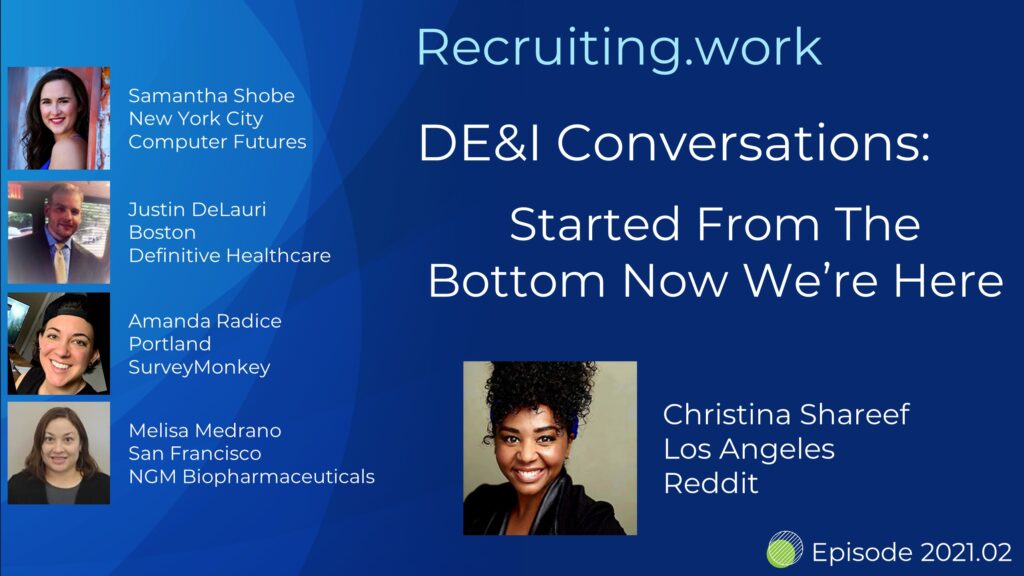With high volume reqs, getting candidates usually isn’t the issue. It’s getting through the ones you have without missing quality candidates.
Let’s discuss ways to work through a high volume of candidates and maintaining a great candidate experience.
Listen in on what our panelists have to say.
This event is part of the “Let’s Talk Recruiting” series where a panel of recruiting practitioners get together online and have a conversation on a variety of topics related to corporate recruiting.
Click to Play the Recording
Our Panelists…
| Name & LinkedIn Profile | Group | Title | Company |
We asked our attendees, “What tip would you give fellow recruiters on how to screen through a large number of candidates that are applying?”
Here are their answers:
Chat Messages from the Session…
10:02:38 >> William Uranga : Hi folks, welcome!
10:02:40 >> Brenda Tern to Sean Rehder(Direct Message) : No worries!
10:03:37 >> David Marr : How would you define High Volume?
10:05:38 >> David Marr : How many prescreens are you having recruiters go through in a day?
10:05:49 >> Matthew Liptak : Could be 50 or more
10:06:14 >> Jodi Greenberg : I{ have 120 Req’s every month
10:06:30 >> Matthew Liptak : 10 min or 115 min
10:07:02 >> Matthew Liptak : 15 min
10:08:06 >> David Marr : What metrics are you tracking?
10:08:28 >> Jenny Shedd to All panelists : is anyone using tools to identify qualified applications. ie. assessments
10:08:34 >> Julie Tramba : Have you used specific technology to help weed out candidates before prescreening?
10:08:53 >> Matthew Liptak : At the time no tech was pre screening
10:09:05 >> Matthew Liptak : But now, yes, there are ways to pre screen
10:09:20 >> Brenda Tern : In past roles, for entry screens we have used video interviewing
10:10:17 >> Jenny Shedd to All panelists : interested best practices in balancing candidate experience with need to get through volume applicants
10:11:27 >> Brenda Tern : @David – we track candidate throughput ratios at each stage of the process
10:11:39 >> Michael Lukens to All panelists : @Brenda, will you share your algorithm formula?
10:11:47 >> William Uranga : Jenny – Best practices start with determine the candidate experience you want to deliver, setting resources and roles to deliver it and then communicating/setting expectations with applicants
10:12:00 >> Brenda Tern : ^^ agree with above
10:12:20 >> Brenda Tern : My team structure is 1-2 recruiter to 1 sourcer
10:12:31 >> William Uranga : Michael – the “algo” will look different from dept to dept and org to org…
10:12:48 >> Brenda Tern : ^^ depending on role as well
10:12:55 >> William Uranga : …start with working backwards and factor in the “through put” as
10:13:04 >> William Uranga : @Brenda shared…
10:13:37 >> Michael Lukens to All panelists : Thanks, that makes sense
10:13:58 >> William Uranga : Example: 1 engineer hire, takes 2 offers, which takes 5 onsite/final video interview, which takes 18 technical screens…etc.
10:14:12 >> Jenny Shedd to All panelists : funnel metrics
10:14:32 >> William Uranga : +1 Jenny, exactly
10:15:21 >> Brenda Tern : Tracking time in stage also will help with pushing candidates through the process more efficiently + keep candidate experience intact
10:16:40 >> William Uranga : Great point, Brenda: time and the conversion ratio are great data points to track.
10:22:47 >> Daniella McDonald : When do you consider a role high-volume or how many reqs do you see as high-volume?
10:22:57 >> Matthew Liptak : 50 requs
10:23:06 >> Matthew Liptak : 40+ openings
10:23:13 >> Matthew Liptak : Same role
10:23:31 >> Daniella McDonald : Thank you Matt
10:23:48 >> Jennifer Levine Reilly : We utilize The Predictive Index
10:23:56 >> Jennifer Levine Reilly : Before the interview
10:24:03 >> Kristine Nemeth to All panelists : Like PI? predictive index?
10:24:08 >> Kristine Nemeth to All panelists : or Watson Glazer?
10:24:11 >> Matthew Liptak : Criteria Corp
10:24:13 >> Matthew Liptak : CCat
10:24:24 >> Matthew Liptak : Myers Briggs
10:24:43 >> Jodi Greenberg : yes, we have a tool built into our software and assessment test
10:25:08 >> Susan Landon : We use Predictive Index as a prescreen for one of our high volume roles.
10:25:21 >> Brenda Tern : @Jennifer, i’d like to learn more about the predictive index
10:25:51 >> Jennifer Levine Reilly : Love Rivs!!
10:26:07 >> David Marr : Indeed has a Video Interviewing Platform that was released in July 2020
10:26:16 >> Daniella McDonald : In my last position we used AllyO text recruiting to screen candidates for some hourly roles and schedule them with hiring managers if they “passed” the screening. They are now part of HireVue.
10:26:18 >> Lara Gartner to All panelists : Candidates don’t like it
10:26:26 >> Barbara Marks : What was the candidate drop off rate for 1-way video?
10:26:39 >> Jenny Shedd : 1-way video can also lead to implicit bias
10:26:41 >> Jenny Shedd to All panelists : curious about candidate experience in video
10:26:59 >> Melissa Rutledge to All panelists : we have VidCruiter for video interviewing and works well for entry level roles, but not as successful at experienced hires and our recruiters felt it didn’t save them time for those roles.
10:27:16 >> David Marr : HoneIT is another interview that records and transcribes your screen and automates the whole process and uploads it into your ATS / CRM
10:28:02 >> Jenny Shedd to All panelists : We’re evaluating Harver. Interesting tool
10:28:30 >> Susan Landon : Predictive Index is simple. Can easily do in 5 minutes on your phone. And candidate gets an informative, interesting written report
10:28:49 >> Melissa Rutledge to All panelists : We have some questions on the application and have our ATS (Lever) autotag based on specific answers to help us identify the strong candidates or weed out the weaker candidates
10:30:09 >> Daniella McDonald : Some candidates might not also want to wait through a process that includes multiple steps or assessments. They don’t see it as relevant and maybe they need a job sooner than that, so they’ll apply to the place that can hire them more quickly.
10:30:33 >> Jodi Greenberg : we require candidates to take assessment once and we can convert it for a different position
10:31:06 >> Matthew Liptak : As soon as the word assessment comes into play you will get candidates that bow out of the process
10:31:16 >> Matthew Liptak : It creates a sour candidate experience
10:33:12 >> Jenny Shedd to All panelists : good ATS systems have files, tagging that allows to create good candidate repositories
10:34:11 >> David Marr : You have to have a way to track your Silver Medalists and a way of capturing those candidates that applied late in the interviewing process and missed being reviewed
10:34:24 >> Matthew Liptak : The pools are key
10:34:35 >> Matthew Liptak : iCIMS has a talent pool technology
10:34:46 >> Matthew Liptak : Broken down by types of role
10:35:04 >> Matthew Liptak : It allows for tagging and categorizing
10:35:17 >> David Marr : Take the time to keep your data clean and capturing the relevant Quality data that’s important for current and future use. For example, making sure to put in country, state, City URLs to profiles, Emails phone #s, assessments, etc
10:38:30 >> William Uranga : +1 David – your data is an investment!
10:39:22 >> David Marr : That’s how Sourcing works at Indeed what Sean Described
10:39:55 >> David Marr : Sourcing owns top of funnel and after candidates are in the system and pass an initial Tech Screen an intro is made to the recruiter and that’s the the hand-off point
10:40:10 >> David Marr : What Matt described is more of a Researcher
10:40:35 >> David Marr : Name Generation and loading into ATS and making available to recruiter
10:40:43 >> Matthew Liptak : correct
10:40:48 >> Matthew Liptak : Sourcing researcher
10:40:57 >> Jodi Greenberg : I just acquired a sourer oversees. I have to figure out how to best utilize her
10:41:03 >> Matthew Liptak : If your company can afford that
10:41:07 >> Stephanie Kramer : We are currently a decentralized model where the HR at our locations do recruitment as just another task within their day. Would you say that centralizing recruitment for high volume helps for pipeline recruitment? We are in healthcare so recruiting for CNA’s, RN’s, housekeeping, etc.
10:41:14 >> Matthew Liptak : But I haven’t worked in a lot of places that have those budgets
10:41:38 >> David Marr : Metrics for Sourcers should also be different then Recruiters in that Sources should be most tracked based upon candidates who make it through entire interviewing process and are approved to get an offer, NOT whether they are hired, as that’s outside of the sources hands
10:43:10 >> David Marr : Swim Lanes. Recruiting Coordinator (Scheduling, administrative), Sourcer (Top of Funnel, herder of passive talent), Recruiter (works with HM, posts job, reviews and screens inbound applicants, etc)
10:43:27 >> David Marr : Sourcers and Recruiters should be working Lock and Step for the process to be successful
10:44:29 >> Jennifer Levine Reilly : How do you track all candidates and where they are in the pipeline?
10:44:50 >> David Marr : Positive candidate experience that incorporates a hiring process that mirrors and reflects what’s important to the org (Culture, Required Skills, Assessments, etc) and the marketing and process should encourage applicants that align with the culture mission of org and discourage applicants that do not
10:45:03 >> David Marr : CRM / ATS @Jennifer Levine Reilly
10:45:28 >> Jennifer Levine Reilly : Thanks David!
10:45:52 >> Jennifer Levine Reilly : Always looking to see if there is something new and shiny on the market! 😉
10:46:19 >> Jenny Shedd to All panelists : Thanks to everyone for your input!
10:46:34 >> Daniella McDonald : Thank you everyone.
10:46:54 >> Jodi Greenberg : Thank you.
10:47:04 >> Lara Gartner to All panelists : Thanks, all
10:47:13 >> David Marr : Loxo, Seekout, ContactOut, Hiretual are all great at doing that
10:47:54 >> Jennifer Levine Reilly : But not free @David
10:48:00 >> Jodi Greenberg : We use SilkRoad
10:48:07 >> Jennifer Levine Reilly : We have a limited budget
10:48:09 >> David Marr : That is correct
10:48:20 >> David Marr : Loxo is like Trello
10:48:25 >> David Marr : Their freemium version is good
10:48:25 >> Katherine Amato to All panelists : Thanks
Some of the attendees…
| Name & LinkedIn Profile | Group | Title | Company |



